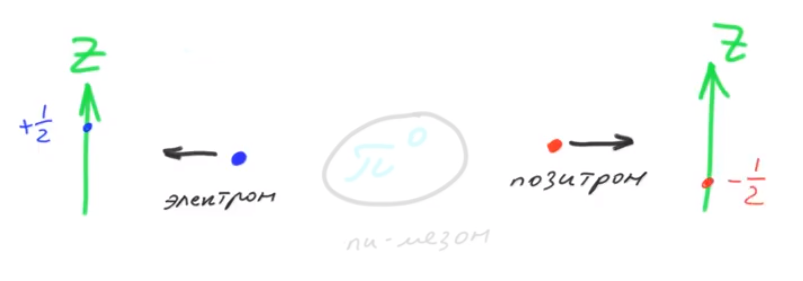
Weak measurements ( weak measurements, interaction-free measurements, reversible measurements, contactless measurements ) are a paradigm quite well-known in narrow circles, even mentioned on Habré . The idea has been put forward and promoted since the 90s by the Israeli school of physicists (Yakir Aaronov, Lev Weidman and many lesser-known personalities) and boils down to the fact that the postulate of quantum mechanics about measurement can supposedly be circumvented.
Here is this unfortunate postulate:
During measurement, the state vector (wave function) collapses into one of the eigenvectors (functions) of the operator of the measured quantity.
Israeli physicists implicitly (and erroneously) believe that collapse occurs when the measuring device interacts with the measured system. Therefore, their logic is as follows: let's think about how to measure a system without physical interaction of anything with this system. Then we will prove that the measurement was made, but the collapse did not occur. And they led the following thought experiment , now widely known thanks to Roger Penrose.
Elitzur-Weidman quantum bombs
Let there be bombs so sensitive that they explode when they hit even one single elementary particle, such as a photon. It is known that some of the bombs are broken, but it is not known which ones. The task is to sort out non-working bombs from workers without detonating the latter.
Under the stated conditions, the task seems insoluble. To test the performance of a bomb, it is necessary to disassemble it or do something else with it. In any case, you will have to touch it, but according to the rules of the game this will lead to an explosion. Indeed, in the framework of classical physics, it is impossible to test such a bomb for operability without detonating it. However, in our quantum world, almost anything is possible.

Place the bomb on one of the arms of the Mach-Zehnder interferometer. Let the mirror be part of the bomb. If the bomb is not working, then the interferometer will be working. Both arms of the interferometer are identical, information on which of the arms passed the photon. Interference will be observed and all photons will fall into the lower detector.
If the bomb gets a working one, then the interferometer will be inoperative. The two shoulders are now not identical. A photon passing along the lower shoulder will lead to a bomb explosion. There will be no interference anymore, since there is information about which of the shoulders the photon passed through (bomb exploded or not).
A photon can bounce off the first translucent mirror, pass along the upper arm, bounce off the second translucent mirror, and fall into the upper detector. But note that in the case of a non-working bomb he could not be in the upper detector - that means the bomb is working. But she did not explode as the photon walked along the upper shoulder. The fixation of the photon by the upper detector indicates that the bomb is operational and at the same time it remains intact.

A more detailed discussion of the Elitzur-Weidman experiment is here .
Have Jewish physicists refuted the measurement postulate by this experiment? Of course not. What is the error in their logic? The problem is that they do not understand that measurement is the receipt by the observer of information , and not the interaction of the system with the measuring device. It is when the observer receives new data that the state vector collapses. The fact that information about the bomb's operability was obtained not by direct physical interaction with the measuring device does not change anything.
Would the founding fathers of quantum mechanics be surprised at such a mental experiment before they were published? Of course not! No wonder they introduced the concept of “observer” into quantum mechanics. If the measuring device were an observer, then this additional physical term would be superfluous.
Who or what is the observer then? One who receives new data is an observer. It is for him that quantum mechanics gives probabilistic predictions of the results of future measurements on the basis of the data currently available to him.
Quantum entanglement and state vector collapse
The fact that collapse is not a physical process, but only updating the observer's knowledge of the system when he received new data, was of course known to the founding fathers. Let us take the classical experiment of quantum entanglement, discussed by Niels Bohr himself in a dispute with Einstein.

The pi-meson decays into an electron and a positron, which fly apart at different ends of the galaxy. Their backs are confused. When measuring both spins with respect to the same axis direction, they will always be opposite in order to give a total of zero.
It is impossible to predict exactly how the spin will turn out without information on the result of measuring the spin of the second particle. Suppose Alice wanted to measure the electron spin relative to the z axis and it turned out to be +1/2. Its state vector collapses into a spin up vector.
What happened to the state vector of the second observer, Bob, following the positron? Nothing. For him, nothing has changed. Alice knows that if Bob wants to measure the positron spin relative to the z axis, then he will get -1/2. But Bob doesn't know that. Its state vector has not collapsed yet. When will collapse happen for Bob?
1. He will measure the positron spin relative to the z axis, detect -1/2, and its vector will collapse into the “spin down” vector.
2. Alice will send him information about the result of her measurement, and upon receipt, the vector will also collapse into a “spin down” relative to the z axis.
The second option is just what Israeli scientists began to call “interaction-free measurements” (non-contact measurements). As you can see, they did not invent anything new but an additional redundant term. The state vector collapses in any case, and precisely at the moment of obtaining new information about the system. This collapse, by definition, is a dimension.
Note that Bob may choose some other axis, not necessarily z. Let's say its axis is several degrees deviated from Alice's axis.

Without information from Alice about the result of her measurement, all Bob’s measurements are absolutely random (this is a property of the singlet state : with respect to any direction of the axis, the spin will be “up” with a 50% probability and down with a 50% probability).
However, if before his measurement he receives information from Alice, then his state vector collapses. Probabilities are redistributed. Let's say 90% that his spin will be “down” and 10% “up” if Alice has “up”. And if Alice’s spin turned “down”, then when this (other) information is received, the vector collapses into another vector, which will give 10% “down” and 90% “up”.
Quantum mechanics allows one to obtain an exact formula for such probability correlations, which also implies that it is impossible to assume the direction of the spin as determined until information about the measurement result is obtained. The spin of the positron at the other end of the universe does not change instantly when measuring the spin of an electron entangled with it, as is often claimed. And yes, superluminal transmission of information is impossible because Alice gets random results when measuring the electron spin.
In general, despite the efforts of Israeli physicists, collapse will not work. When measuring (obtaining new data), the vector collapses, which simply reflects the updating of the observer’s subjective knowledge of the system, which are encoded in this vector (wave function).
Homework for Adherents of a World-Wide Interpretation: Get the Same Results from Everett’s Concept. Tell me exactly when the world is divided in this case and how many branches.
The "paradox" of the pigeon's nest
But Israeli physicists do not give up and this is another article in which the authors (Aaronov at al.) Use the described approach “ measurement does not always lead to collapse ” to derive such an absurd statement that:
Three pigeons can be crammed into two pigeon holes, and there will not be two pigeons in any of the holes.

This is what happens if we neglect the postulates of quantum mechanics! The incompatibility of this statement of Jewish physicists with quantum mechanics has been shown many times. I recommend an article by former Harvard professor Lubos Motl entitled “ Three pigeon holes in the brains of six physicists .”